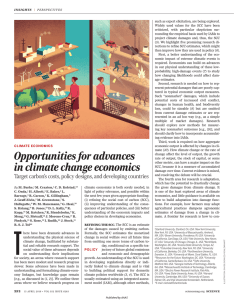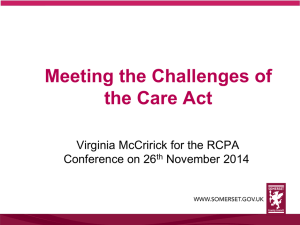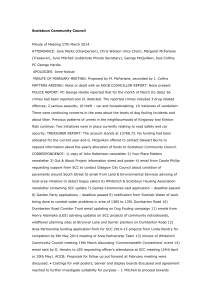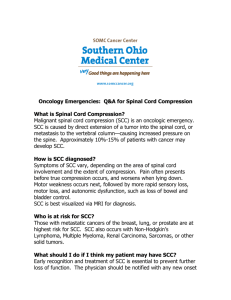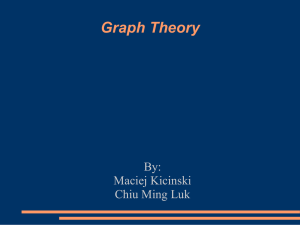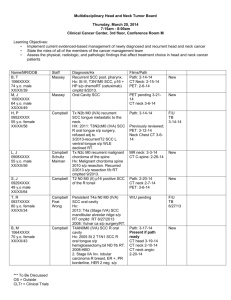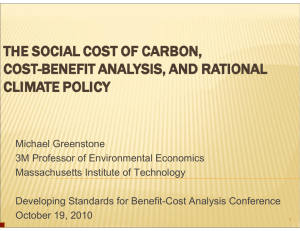Document
advertisement
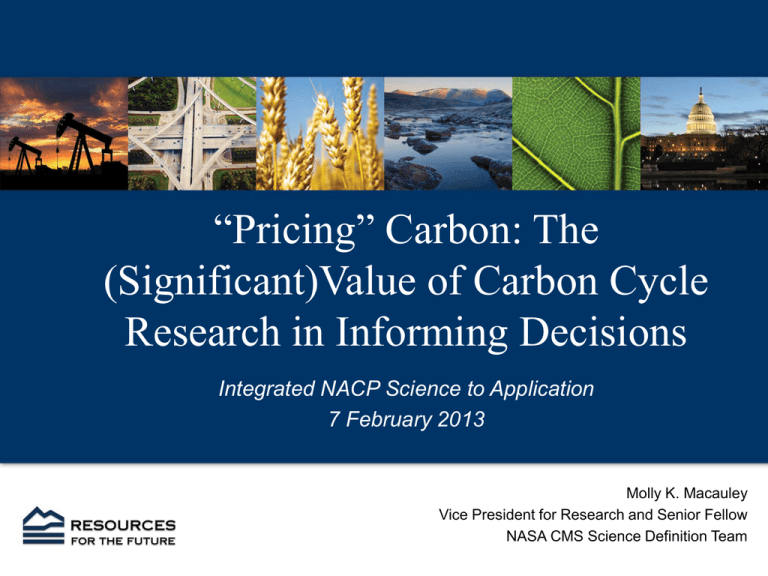
“Pricing” Carbon: The (Significant)Value of Carbon Cycle Research in Informing Decisions Integrated NACP Science to Application 7 February 2013 Molly K. Macauley Vice President for Research and Senior Fellow NASA CMS Science Definition Team The US “social cost of carbon” Climate sensitivity parameter Mean averted damages by switching with EO vs AltI [Trill USD 2015], BAU ->DICE Opt. 95% confidence, 0.2C/decade trigger VOI: BAU -> DICE Optimum @ 0.2C/decade mean damages [Trill USD 2015] stdev BAU 2.5% 40.08 18.55 BAU 3% 24.61 10.95 BAU 5% 5.48 2.06 8.32 4.19 6.22 2.36 2.56 0.43 10.74 4.74 7.88 2.51 3.06 0.37 with 95% certainty: VOI-EO 2.5% Discovered by VOI-EO 3% EO VOI-EO 5% VOI-A/C/I 2.5% Discovered by Alternative VOI-A/C/I 3% VOI-A/C/I 5% discount rate 2.5% 2.43 3% 1.66 5% 0.50 Shaded charts: Preliminary– Pls do not quote/cite Wielicki, Young, and Cooke DRAFT 2012; Discount Rate from US SCCC 2010 3 Applications of the SCC The SCC is to enable estimates of economic damages to be taken into account in regulatory actions that require (by law or statute) the balancing of benefits and costs to meet GHG emissions standards. The SCC has been used in about 20 regulatory decisions so far. Examples: • Fuel efficiency standards (US Dept of Transportation) • New boiler efficiency standards (US Dept of Energy, US EPA) 4 Estimation of the SCC, part 1 Assumptions: Changes in future emissions of GHGs; the effects of past and future emissions on the climate system; the effect of changes in climate on the physical and biological environment; the translation of the env’l impacts into economic damages. Default Methodology: Use integrated assessment models (DICE, PAGE, and FUND) – but at expense of a detailed representation of the underlying climatic and economic systems Greenstone, Kopits and Wolverton 2013 5 Estimation of the SCC, part 2 Steps: Translate changes in emissions into changes in atmos GHG concentrations using the carbon cycles built into the IAMs, then changes in temp using a representation of the climate and “climate sensitivity,” then effects are monetized based on functions that make assumptions about adaptation and translate physical effects into economic damages (using a discount rate to convert the stream of economic damages over time into a single value) Greenstone, Kopits and Wolverton 2013 6 Estimation of the SCC, part 3 Equilibrium climate sensitivity: Determines the speed and magnitude of temperature change for a given emissions path. Defined as the increase in the annual global-average surface temperature from a doubling of atmospheric CO2 concentrations relative to preindustrial levels; a short- to medium-term response (100 to 200 years); does not include feedback effects due to possible large-scale changes in ice sheets or the biosphere Greenstone, Kopits and Wolverton 2013 7 SCC Needs CMS Large uncertainties in the climate sensitivity parameter (as well as other assumptions) The US Federal Interagency report describing the analysis establishing the SCC expressed “all due humility” about the limitations of the analysis and pledged that the United States government would periodically review and reconsider SCC estimates. US Department of Energy 2010 8 SCC Needs CMS, continued Our aim here is to describe these assumptions in sufficient detail to enable readers to conduct their own research and suggest improvements so that future efforts to revise the SCC will rely on a methodology that improves on the one described here. Greenstone, Kopits and Wolverton 2013 9 Engage more fully with the social scientists? • Huge demand and interest to improve approach • Consequential parameter for decisionmaking and it is the “law of the land” (through regulation) • Invitation extended to improve 10 References US Interagency Working Group on Social Cost of Carbon, Technical Support Document: Social Cost of Carbon for Regulatory Impact Analysis Under Executive Order 12866, February 2010, at http://www.epa.gov/otaq/climate/regulations/scc-tsd.pdf Greenstone, M., E. Kopits, and A. Wolverton. 2013. “Developing a Social Cost of Carbon for US Regulatory Analysis: A Methodology and Interpretation,” Review of Environmental Economics and Policy 7(1), 23-46. 11

